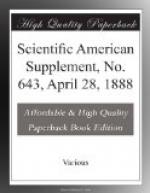“Poisons and poisoning” was the subject of a discourse a few days ago at the Royal Institution. The lecturer, Professor Meymott Tidy, began by directing attention to the derivation of the word “toxicology,” the science of poisons. The Greek word [Greek: toxon] signified primarily that specially oriental weapon which we call a bow, but the word in the earliest authors included in its meaning the arrow shot from the bow. Dioscorides in the first century A.D. uses the word [Greek: to toxikon] to signify the poison to smear arrows with. Thus, by giving an enlarged sense to the word—for words ever strive to keep pace, if possible, with scientific progress, we get our modern and significant expression toxicology as the science of poisons and of poisoning. A certain grim historical interest gathers around the story of poisons.
It is a history worth studying, for poisons have played their part in history. The “subtil serpent” taught men the power of a poisoned fang. Poison was in the first instance a simple instrument of open warfare. Thus, our savage ancestors tipped their arrows with the snake poison in order to render them more deadly. The use of vegetable extracts for this purpose belongs to a later period. The suggestion is not unreasonable that if war chemists with their powders, their gun cotton, and their explosives had not been invented, warlike nations would have turned for their instrumenta belli to toxicologists and their poisons. At any rate, the toxicologists may claim that the very cradle of science was rocked in the laboratory of the toxicological worker. Early in the history of arrow tipping the admixture of blood with the snake poison became a common practice. Even the use of animal fluids alone is recorded—e.g., the arrows of Hercules, which were dipped in the gall of the Lernaean hydra. Hercules himself at last fell a victim to the blood stained tunic of the dead Centaur Nessus. As late as the middle of the last century Blumenbach persuaded one of his class to drink 7 oz. of warm bullock’s blood in order to disprove the then popular notion that even fresh blood was a poison. The young man who consented to drink the blood did not die a martyr to science.
The first important question we have to answer is, What do we mean by a poison? The law has not defined a poison, although it requires at times a definition. The popular definition of a poison is “a drug which destroys life rapidly when taken in small quantity.” The terms “small quantity” as regards amount, and “rapidly” as regards time, are as indefinite as Hodge’s “piece of chalk” as regards size. The professor defined a poison as “any substance which otherwise than by the agency of heat or electricity is capable of destroying life, either by chemical action on the tissues of the living body or by physiological action by absorption into the living system.” This definition excepted from the list of poisons all agencies that destroyed life by a simple mechanical




